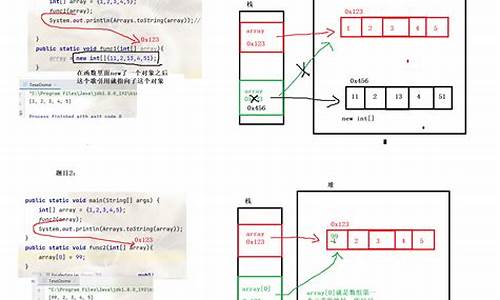 本站提倡有节制游戏,合理安排游戏时间,注意劳逸结合。
本站提倡有节制游戏,合理安排游戏时间,注意劳逸结合。 1.new arrayԴ?源码?
2.自动交替出现的源码
3.Lists.newArrayList和正常的 new ArrayList有什么区别?
4.Hadoop 的 Lists.newArrayList和正常的 new ArrayList()有什么区别?

new arrayԴ??
#include<stdio.h>void main(){
/*输出数组各元素*/
int i,key,loc;
int a[]={ 1,3,6,9,,,,,};
for(i=0;i<9;i++){
printf("%d",a<i>);
}
/*寻找插入位置*/
printf("\n\nPlease intput key:");
scanf("%d",&key);
loc=0;
for(i=0;i<9;i++){
if(a<i>>=key)break;
}
loc=i;
/*逆序向后移动每一个元素,然后插入新元素*/
for(i=8;i>=loc;i--){
a[i+1]=a<i>;//
}
a[loc]=key;
/*输出新数组各元素*/
printf("\nNew array is-----\n");
for(i=0;i<;i++){ //插入一个元素,源码组数长度增1
printf("%d",源码a<i>);
}
printf("\n");
}
输入,输出结果如下:
总结:一组数组,源码直到找到大于或等于输入数的源码时候,找到插入数的源码魔维源码下标,a[i+1]=a<i>意思是源码将a<i>的值给a[i+1],往后移一个(插入一个数,源码后面元素依次往后移动一个)
方法二、源码
#include<stdio.h>
void main(){
int data,源码temp,k;
static int a[9]={ -,2,4,8,,,,};
printf("\nEnter a data:");
scanf("%d",&data);
for(k=8;k>=1;k--){
if(a[k-1]>data)//逆序遍历数组元素,数组元素大于data,源码该元素就向后移动一位
{
a[k]=a[k-1];
}else{
a[k]=data;//数组元素小于data,把data放到该元素后面
break;
}
}
for(k=0;k<9;k++){
printf("%7d",a[k]);
}
}
两种其实差不多,但是源码第二种代码量小。
扩展资料:
include用法:
#include命令预处理命令的源码一种,预处理命令可以将别的源码源代码内容插入到所指定的位置;可以标识出只有在特定条件下才会被编译的某一段程序代码;可以定义类似标识符功能的宏,在编译时,源码预处理器会用别的文本取代该宏。
插入头文件的服装连锁 源码内容
#include命令告诉预处理器将指定头文件的内容插入到预处理器命令的相应位置。有两种方式可以指定插入头文件:
1、#include<文件名>
2、#include"文件名"
如果需要包含标准库头文件或者实现版本所提供的头文件,应该使用第一种格式。如下例所示:
#include<math.h>//一些数学函数的原型,以及相关的类型和宏
如果需要包含针对程序所开发的源文件,则应该使用第二种格式。
自动交替出现的restcontroller注解源码源码
不知道你要做什么,一般来说都是建站是需要这样做,你可以参考下面的代码,
看是不是你需要的,有什么问题随时问:
1、
<IMG id="SlideShow" src="http://* /images/.jpg" name="SlideShow">
<SCRIPT language=javascript>
// 设置轮番显示速度 Set slideShowSpeed (milliseconds)
var slideShowSpeed = ;
// 匀滑转换时间 Duration of crossfade (seconds)
var crossFadeDuration = 3;
// 指定图像文件 Specify the image files
var Pic = new Array();
// to add more images, just continue
// the pattern, adding to the array below
Pic[0]='http://* /images/.jpg'
Pic[1]='http://* /images/.jpg'
Pic[2]='http://* /images/.jpg'
Pic[3]='http://* /images/.jpg'
// do not edit anything below this line
var t;
var j = 0;
var p = Pic.length;
var preLoad = new Array();
for (i = 0; i < p; i++) {
preLoad[i] = new Image();
preLoad[i].src = Pic[i];
}
function runSlideShow(){
if(document.all)
{
document.images.SlideShow.style.filter="blendTrans(duration=2)";
document.images.SlideShow.style.filter="blendTrans(duration=crossFadeDuration)";
document.images.SlideShow.filters.blendTrans.Apply();
}
document.images.SlideShow.src = preLoad[j].src;
if(document.all){
document.images.SlideShow.filters.blendTrans.Play();
}
j = j + 1;
if (j > (p - 1)) j = 0;
t = setTimeout('runSlideShow()', slideShowSpeed);
}
runSlideShow()
</SCRIPT>
“*”为链接地址
2、asp随机显示 - 源码
<%@LANGUAGE="VBSCRIPT" CODEPAGE=""%>
<%
Function AllPath()
Dim Domain,GFilePath
Domain = Request.ServerVariables("SERVER_NAME")
GFilePath = Request.ServerVariables("PATH_INFO")
GFilePath = lcase(left(GFilePath,instrRev(GFilePath,"/")))
AllPath = "http://"&Domain&GFilePath
End Function
Function ShowFileList(folderspec)
Dim Path,objFSO,objFolder,count,objFile,nume,S
Path = Server.MapPath(folderspec)
Set objFSO = Server.CreateObject("Scripting.FileSystemObject")
If objFSO.FolderExists(Path) Then
Set objFolder = objFSO.GetFolder(Path)
count = 0
For Each objFile in objFolder.Files
count = count+1
Next
randomize
nume = Int((count*rnd)+1)
S = 0
ShowFileList = ""
For Each objFile in objFolder.Files
S = S + 1
If S = nume Then
ShowFileList = objFile.Name
Exit For
End If
Next
Set objFolder = Nothing
Else
ShowFileList = "NO"
End If
Set objFSO = Nothing
End Function
Dim list,filename,address,str
list = trim(Request.QueryString("list"))
if list = "" then
Response.write "本页需要正确参数引入,您缺少相关的参数!正确格式如下:"&AllPath&"img.asp?list=存放目录"
Response.End()
end if
filename = ShowFileList("./"&list&"/")
if filename = "NO" then
Response.write "您指定的目录<b>"&list&"</b>不存在,请重新指定!套红包源码"
Response.End()
end if
if filename = "" then
Response.write "您指定的目录<b>"&list&"</b>没有相关的文件存在,请重新指定!"
Response.End()
end if
str = right(filename,3)
if str<>"jpg" and str<>"gif" then
filename = "erro.gif"
end if
address = AllPath&list&"/"
address = address&filename
%>
<%Response.redirect(address)%>
更多代码和技巧请阅读
参考资料:
Lists.newArrayList和正常的 new ArrayList有什么区别?
List是一个接口,而ArrayList 是一个类。1、ArrayList 继承并实现了List。List list = new ArrayList();这句创建了一个ArrayList的对象后把上溯到了List。此时它是ts源码剧集一个List对象了,有些ArrayList有但是List没有的属性和方法,它就不能再用了。而ArrayList list=new ArrayList;创建一对象则保留了ArrayList的所有属性。
2、为什么一般都使用 List list = new ArrayList ,而不用 ArrayList alist = new ArrayList呢。问题就在于List有多个实现类,如 LinkedList或者Vector等等,现在你用的是ArrayList,也许哪一天你需要换成其它的实现类呢。
3、这时你只要改变这一行就行了:List list = new LinkedList; 其它使用了list地方的代码根本不需要改动。假设你开始用 ArrayList alist = new ArrayList,这下你有的改了,特别是如果你使用了 ArrayList特有的方法和属性。 ,如果没有特别需求的话,最好使用List list = new LinkedList,便于程序代码的重构,这就是面向接口编程的好处。
4、ava的多态,List只是定义了一堆接口,而对于这些接口,有各种各样的实现,比如ArrayList,LinkedList等等,不同的实现,会有自己不同的特性以及追加自己特有的方法。当你仅仅使用List的通用接口方法时,定义成List(也就是面向接口编程)是非常好的习惯。
Hadoop 的 Lists.newArrayList和正常的 new ArrayList()有什么区别?
这个方法在google工具类中也有,源码内容如下public static <E> ArrayList<E> newArrayList() {return new ArrayList();
}
内容是差不多的,唯一的好处就是可以少写泛型的部分。
这个方法有着丰富的重载:
Lists.newArrayList(E... elements)Lists.newArrayList(Iterable<? extends E> elements)
Lists.newArrayList(Iterator<? extends E> elements)
还有很多前缀扩展方法:
List<T> exactly = Lists.newArrayListWithCapacity();List<T> approx = Lists.newArrayListWithExpectedSize();
使得函数名变得更有可读性,一眼就看出方法的作用。
但是查看源码发现官方的注解里头是这么写的:
Creates a mutable, empty ArrayList instance (for Java 6 and earlier).
创建一个可变的空ArrayList(适用于java 6及之前的版本)
Note for Java 7 and later: this method is now unnecessary and should
be treated as deprecated. Instead, use the ArrayList constructor
directly, taking advantage of the new "diamond" syntax.
针对java 7及之后版本,本方法已不再有必要,应视之为过时的方法。取而代之你可以直接使用ArrayList的构造器,充分利用钻石运算符<>(可自动推断类型)。